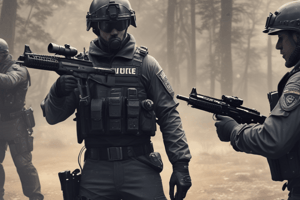Podcast
Questions and Answers
What is the first line of defense in self-defense?
What is the first line of defense in self-defense?
- Situational awareness (correct)
- Physical techniques
- Strategic thinking
- Body language
Which of the following is NOT a tip to maximize awareness in self-defense?
Which of the following is NOT a tip to maximize awareness in self-defense?
- Know your environment and common escape routes
- Focus on surroundings and identify potential hiding spots
- Avoid looking for people or objects that seem out of place (correct)
- Stay alert and scan surroundings frequently
What is an effective self-defense technique for disorienting an attacker or signaling for help?
What is an effective self-defense technique for disorienting an attacker or signaling for help?
- Knee strikes
- Elbow strikes
- Hand strikes (correct)
- Foot stomps
Why is targeting the attacker's knees considered a useful self-defense technique?
Why is targeting the attacker's knees considered a useful self-defense technique?
Which aspect is NOT a part of a comprehensive approach to self-defense?
Which aspect is NOT a part of a comprehensive approach to self-defense?
What is one important self-defense strategy besides techniques?
What is one important self-defense strategy besides techniques?
Which of the following is a common attack in self-defense scenarios?
Which of the following is a common attack in self-defense scenarios?
Why is physical fitness important in self-defense?
Why is physical fitness important in self-defense?
What should you do if something feels uncomfortable or off in a situation?
What should you do if something feels uncomfortable or off in a situation?
How can flexibility training benefit your self-defense skills?
How can flexibility training benefit your self-defense skills?
Flashcards are hidden until you start studying
Study Notes
Self-Defense: Staying Safe and Prepared
Self-defense isn't just about learning physical techniques; it's a comprehensive approach to personal safety that encompasses body language, situational awareness, and strategic thinking. In this article, we'll delve into the various aspects of self-defense that contribute to a safer and more secure lifestyle.
Awareness
Awareness is the first line of defense. By developing your situational awareness, you'll be able to spot potential threats and potential escape routes before anything occurs. Here are some tips to maximize your awareness:
- Stay alert: Practice scanning your surroundings frequently, especially in crowded or unfamiliar areas.
- Focus on your surroundings: Look for people or objects that seem out of place, and identify potential hiding spots for an attacker.
- Know your environment: Familiarize yourself with your surroundings, especially common escape routes, public phones, and areas where help is likely to be nearby.
Basic Techniques
Self-defense techniques are designed to be simple, effective, and easy to remember. Here are a few basic techniques that can be a good starting point:
- Hand strikes: Punching and slapping are effective techniques for disorienting an attacker or signaling for help.
- Knee strikes: Targeting the attacker's knees can slow them down and disrupt their balance.
- Escapes from grabs: Learning to escape from common grabs, such as wrist grabs and chokes, is crucial for self-defense.
Self-Defense Strategies
Self-defense strategies go beyond just techniques; they also include ways to avoid confrontations, de-escalate tense situations, and minimize the risk of injury. Here are some strategies to keep in mind:
- Empower yourself: Be confident and assertive in your body language and speech to convey that you are not an easy target.
- Trust your instincts: If something feels off or uncomfortable, trust your instincts and remove yourself from the situation.
- Learn to say "no": Asserting your boundaries is an important part of self-defense. Practice saying "no" confidently and assertively.
Common Attacks
Knowing the most common attacks can help you prepare for potential situations and react more effectively. Here are some common attacks to be aware of:
- Wrist grabs: A popular attack used to control and restrain the victim.
- Chokes: Attackers may try to choke you to disrupt your breathing and render you unconscious.
- Groin kicks and punches: Attackers may target the groin area to cause pain and disorientation.
Physical Fitness
Physical fitness plays a crucial role in self-defense. A strong and fit body will be better able to handle physical confrontations and recover from injuries more quickly. Here are some tips to improve your physical fitness for self-defense:
- Cardiovascular fitness: Aerobic exercises, such as jogging or swimming, can improve your endurance and help you stay calm and focused during a self-defense situation.
- Strength training: Weightlifting or bodyweight exercises will help you build muscle, which can increase your strength and power during a self-defense situation.
- Flexibility training: Yoga or stretching exercises can improve your flexibility and reduce the risk of injury during a self-defense situation.
Keep Learning and Practicing
Self-defense is an ongoing journey that requires continuous learning and practice. By staying aware, exercising regularly, and practicing self-defense techniques, you'll be better equipped to handle dangerous situations and stay safe.
Remember, self-defense is not just about physical techniques; it's a holistic approach to personal safety that includes situational awareness, assertiveness, and the ability to de-escalate tense situations. By developing these skills, you'll be better prepared to protect yourself and others.
Studying That Suits You
Use AI to generate personalized quizzes and flashcards to suit your learning preferences.



